
Nightjars are medium-sized nocturnal or crepuscular birds in the family Caprimulgidae and order Caprimulgiformes, characterised by long wings, short legs, and very short bills. They are sometimes called goatsuckers, due to the ancient folk tale that they sucked the milk from goats, or bugeaters, their primary source of food being insects. Some New World species are called nighthawks. The English word "nightjar" originally referred to the European nightjar.
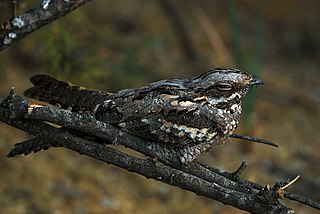
The European nightjar, common goatsucker, Eurasian nightjar or just nightjar, is a crepuscular and nocturnal bird in the nightjar family that breeds across most of Europe and the Palearctic to Mongolia and Northwestern China. The Latin generic name refers to the old myth that the nocturnal nightjar suckled from goats, causing them to cease to give milk. The six subspecies differ clinally, the birds becoming smaller and paler towards the east of the range. All populations are migratory, wintering in sub-Saharan Africa. Their densely patterned grey and brown plumage makes individuals difficult to see in the daytime when they rest on the ground or perch motionless along a branch, although the male shows white patches in the wings and tail as he flies at night.

The nighthawk is a nocturnal bird of the subfamily Chordeilinae, within the nightjar family, Caprimulgidae, native to the western hemisphere. The term "nighthawk", first recorded in the King James Bible of 1611, was originally a local name in England for the European nightjar. Its use in the Americas to refer to members of the genus Chordeiles and related genera was first recorded in 1778.

The cream-colored courser is a wader in the pratincole and courser family, Glareolidae. Both parts of the scientific name derive from Latin cursor, "runner", from currere, "to run" which describes their usual habit as they hunt their insect prey on the ground in dry open semi-desert regions of the Middle East and northern Africa.

The red-necked nightjar is the largest of the nightjars occurring in Europe. It breeds in Iberia and North Africa, and winters in tropical West Africa.

The standard-winged nightjar is a nocturnal bird in the nightjar family.

The Indian nightjar is a small nightjar which is a resident breeder in open lands across South Asia and Southeast Asia. Like most nightjars it is crepuscular and is best detected from its characteristic calls at dawn and dusk that have been likened to a stone skipping on a frozen lake - a series of clicks that become shorter and more rapid. They are sometimes spotted on roads when their eyes gleam red in the spotlight of a vehicle. There is considerable plumage variation across its range and can be hard to differentiate from other nightjars in the region especially in the field.

Jerdon's nightjar is a medium-sized nightjar species native to southern India and Sri Lanka. Formerly considered as a subspecies of the long-tailed nightjar, it is best recognized by its distinctive call which sounds like a wooden plank being beaten periodically with each note ending in a quaver. The common name commemorates Thomas C. Jerdon who described the species.
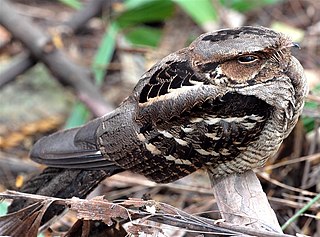
Caprimulgus is a large and very widespread genus of nightjars, medium-sized nocturnal birds with long pointed wings, short legs and short bills. Caprimulgus is derived from the Latin capra, "nanny goat", and mulgere, "to milk", referring to an old myth that nightjars suck milk from goats. The common name "nightjar", first recorded in 1630, refers to the nocturnal habits of the bird, the second part of the name deriving from the distinctive churring song.

The common poorwill is a nocturnal bird of the family Caprimulgidae, the nightjars. It is found from British Columbia and southeastern Alberta, through the western United States to northern Mexico. The bird's habitat is dry, open areas with grasses or shrubs, and even stony desert slopes with very little vegetation.
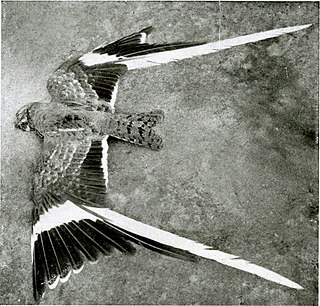
The pennant-winged nightjar is a species of nightjar that occurs from Nigeria to northern South Africa. It is an intra-African migrant and displays remarkable sexual dimorphism in the breeding season.

Bates's nightjar or the forest nightjar, is a bird species of the family Caprimulgidae, found in the rainforests of western Sub-Saharan Africa.
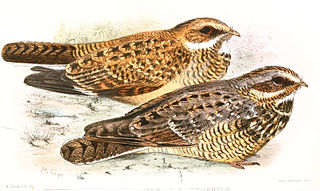
The swamp nightjar or Natal nightjar is a crepuscular and nocturnal bird in the nightjar family found in Africa.

The Nubian nightjar is a species of nightjar in the family Caprimulgidae. It is found in salt marshes of Djibouti, Egypt, Eritrea, Ethiopia, Israel, Kenya, Oman, Saudi Arabia, Somalia, Sudan, and Yemen.

The montane nightjar, mountain nightjar or Abyssinian nightjar, is a species of nightjar in the family Caprimulgidae. It is native to upland regions of Central and Eastern Africa where it is a locally common species.

The freckled nightjar or freckled rock nightjar is a species of nightjar in the family Caprimulgidae. It has a wide yet patchy distribution throughout the Afrotropics.
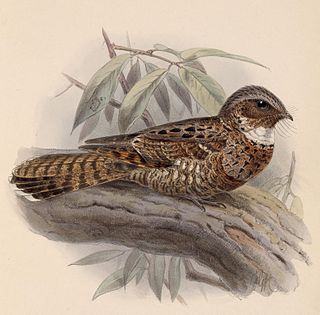
The Yucatan poorwill is a species of nightjar in the family Caprimulgidae. It is found in the Yucatán Peninsula of Belize, Guatemala, and Mexico.

Antrostomus is a genus of nightjars formerly included in the genus Caprimulgus. They are medium-sized nocturnal birds with long pointed wings, short legs and short bills.





















